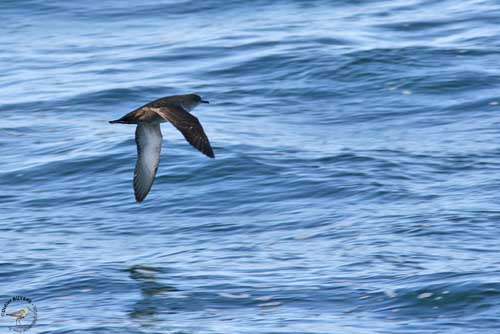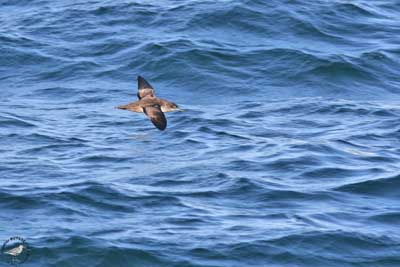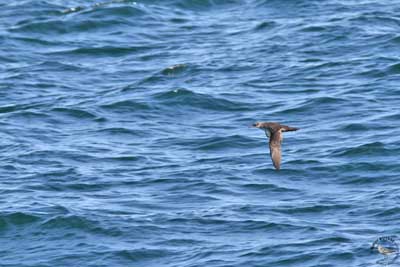
Balearic Shearwater
Puffinus mauretanicus
Procellariiforme Order – Procellariidae Family
BIOMETRICS :
Length: 35-40 cm
Wingspan: 85-90 cm
LONGEVITY: More than 20 years
DESCRIPTION:
The Balearic Shearwater is a subspecies of Puffinus yelkouan. It is slightly larger. Both sexes are similar.
Upperparts are dark brown, slightly darker on flight feathers and tail. Underwing is whitish, spotted with brown, with narrow dark brown edge and broad diffused wash. Primary fathers are dark brown. Underparts vary from white to brown.
Bill is dark grey. Eyes are dark brown. Legs and feet are pink, with blackish-tipped toes.
PROTECTION / THREATS / STATUS:
Some declines of this species are expected in the next three generations, due to intensive fishing and poisoning by oils which play an important role in these declines.
Human developments on the coasts are another threat, and introduced cats and rats are the main predators of this bird.
Important protection measures are in progress, some of them already on the way, such as installation of nest-boxes in suitable areas.
Fr: Puffin des Baléares
All : Balearen Schwarzschnabel-Sturmtaucher
Esp : Pardela Balear
Ital : Berta minore delle Baleari
Nd : Vale Pijlstormvogel
Sd: Balearisk lira
Photographs by Didier Buysse
Vision d’Oiseaux
Text by Nicole Bouglouan
Sources :
HANDBOOK OF THE BIRDS OF THE WORLD vol 1 by Josep del Hoyo-Andrew Elliot-Jordi Sargatal - Lynx Edicions - ISBN: 8487334105
THE HANDBOOK OF BIRD IDENTIFICATION FOR EUROPE AND THE WESTERN PALEARCTIC by Mark Beaman, Steve Madge - C.Helm - ISBN: 0713639601
Wikipedia (Wikipedia, The Free Encyclopedia)
BirdLife International (BirdLife International)

The typical birds have whitish throat and belly, with diffuse brown band on breast and flanks. Undertail feathers are dark brown.
The palest birds are rather white, the brown upperparts contrasting with the white underparts.
The darkest birds are rather brown on the underparts, with only belly and throat slightly paler.
VOICE: SOUNDS BY XENO-CANTO
The Balearic Shearwater is silent at sea. However, it utters drawling sounds, and thin repeated “a-uuu-ah-ééh”.
At night, colonies are noisy, and we can hear loud calls and chattering.
HABITAT:
The Balearic Shearwater nests on islands, in caves or rocky crevices in the coastal cliffs, and form relatively small colonies.
Outside this period, the Balearic Shearwater is strictly marine, only feeding on continental shelves.
RANGE:
The Balearic Shearwater exclusively breeds on Balearic Islands, but from June to October, it may be seen in eastern Atlantic Ocean, between the south of the North Sea and Morocco.

BEHAVIOUR:
The Balearic Shearwater usually feeds in groups. It may sometimes follow the fish boats. It forages into sardines’ shoals. It dives from short height, and may remain underwater during about 66 seconds during which it pursues the prey and catches it.
The Balearic Shearwater is well adapted for diving, with legs of elliptic section in order to reduce the resistance to the water, and very developed wing muscles to propel itself under water.
This technique allows the species to feed far from the boat, more than other seabirds. It is able to capture preys sinking into the water behind the boat.

FLIGHT:
The Balearic Shearwater performs fast flight with powerful wing beats and short glides at about 1, 20 to 3 metres from the surface. The wings are held and are at right angle to the body.
REPRODUCTION:
The Balearic Shearwater breeds in colonies on islands. The nest is inside a burrow dug into the high coastal cliffs or on rocky islets. Burrows are more than one metre depth. The nests may be placed between a few metres to 100 metres high on the cliff.
It is a small depression made into sandy or clayey soil, but it is often on the rock. There is not addition of other materials.
The Balearic Shearwater arrives at breeding areas in September/October. The female lays one single white egg in February/March. Incubation lasts about 50 days.
The most part of the young flies in late June/early July. They need 70 days for fledging.
Parents feed the chick during the first 15 days, and then, they abandon the young during the day and come back only at dusk, in order to avoid the predators such as Larus marinus - the Great Black-backed Gull
DIET:
The Balearic Shearwater feeds mainly on fish, primarily sardines, and molluscs.
